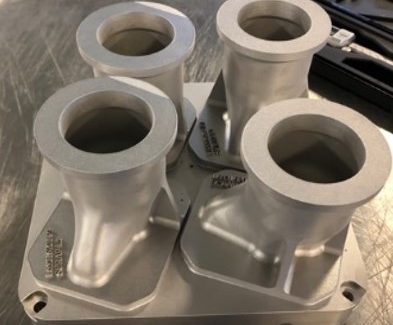GE Aviation, GE Additive Engineers Switching to Metal 3D Printing for Four Existing Parts
GE Aviation has decided to switch from investment casting to additive manufacturing for four parts based on cost and time to market.
Posted: June 7, 2021
As 3D-printed pieces, the four parts may reduce cost by as much as 35 percent, enough to justify permanently retiring the old casting molds. Also, the conversion process took only 10 months to go from identifying target parts to 3D printing of final prototypes. Ordinarily, producing aerospace and land/marine turbine parts using a casting process takes 12 to 18 months or more.
“This is a game-changer,” says Eric Gatlin, GE Aviation additive manufacturing leader. “This is the first time we did a part-for-part replacement, and it was cheaper doing it with additive than casting. To make sure we demonstrated cost competitiveness, we had four outside vendors quote the parts, and we still came in lower with additive manufacturing.”
The four parts are the result of a collaboration between GE Aviation (Evendale, OH) and GE Additive (Cincinnati, OH). An operating unit of General Electric, GE Aviation provides many products for use in commercial, military, business, and general aviation aircraft. Among those products are jet and turboprop engines, electrical power systems, and mechanical systems. Involved in metal additive design and manufacturing, GE Additive includes additive machine brands Concept Laser and Arcam EBM, along with additive powder supplier AP&C.
The four converted parts may be only the beginning. Scores of other parts on various engines have been identified for possible conversion to additive manufacturing. Conversion could also reduce the costs of these other parts.
Additive manufacturing has been growing more competitive for years. This is especially true for new aircraft engine programs. The 3D-printed fuel nozzle tip for GE Aviation’s LEAP engine, for example, consolidates 20 different parts—and the steps needed to machine and assemble them—into one single structure. The company’s new turboprop engine took that to another level by combining an astonishing 855 parts into just 10 3D-printed components. In both cases (and others), GE Aviation took advantage of parts consolidation to squeeze major cost savings from assembling the parts.
And with the number of demanding applications growing, equipment makers have worked to improve the productivity of their metal laser printers, which build parts from metal powders, one thin layer at a time.
One example is GE Additive’s Concept Laser M2 Series 5 machine. Its dual lasers melt and fuse metal layers faster than a single laser alone and produce more consistent results for complex builds. The M2’s lasers are also powerful, either 400 watts or 1 kilowatt, and produce 50-micron-thick layers. The M2 machine also has a large, 21,000-cubic-centimeter build chamber in which to make parts.
The four 3D-printed parts were selected for additive manufacture from a much larger pool of parts. An aspect of the selection process was looking only at parts that would fit inside a Concept Laser M2 machine. “In production, we opted for the M2 because we know it well,” says GE Aviation’s Gatlin.
The four selected parts are adapter caps for the bleed air system of the LM9000, a land/marine turbine derived from the GE90 turbojet, which GE Aviation is building for Baker Hughes. Each of the four parts was about 3.5 inches in diameter and about 6 inches tall.
Put through simulation and analysis, the 3D-printed parts showed that they performed the same as their cast counterparts, says Steve Slusher, a GE Additive manufacturing engineer.
Jeff Eschenbach, a GE Aviation senior project manager, adds: “The thing that stuck out to me was that we could take an existing casting design, replicate it quickly on our printers, and within weeks of starting on the project, the final parts were the same quality as to their cast counterparts. This project serves as a template for future work.”















